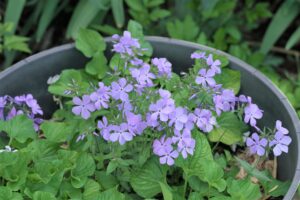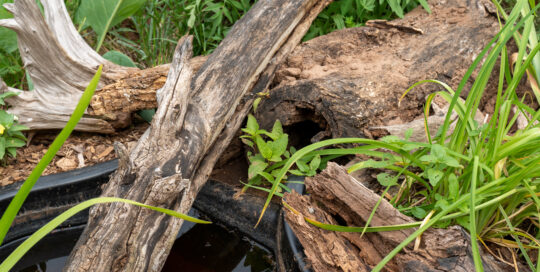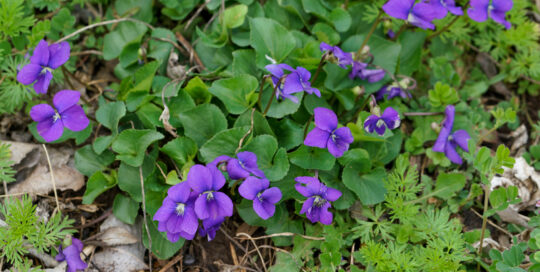- Home
- /
- Wildlife Gardening Journal
- /
- Early spring is time to plant native spring ephemerals
Early spring is time to plant native spring ephemerals
Views: 118

Spring arrived early here at SunDog House, and my non-native spring ephemerals – crocuses, daffodils, grape hyacinths, and tulips – are blooming. My native ephemerals are emerging, as well. My lawn has spring beauties (likely Claytonia virginica), and my native violets are blooming. Woodland phlox is coming up in its container. The calendar says we’re barely into spring, so it’s still a good time to plant native spring ephemerals.
What are Ephemerals?
A spring ephemeral is a type of herbaceous plant that typically emerges during the early spring months, quickly flowering and setting seed. These plants have short life cycles. Their foliage usually dies back by late spring or early summer, allowing them to remain dormant until the following spring. Spring ephemerals are often found in forests, emerging before the trees leaf out, taking advantage of the late winter/early spring sunlight. However, in garden use, spring ephemerals are certainly not limited to forested areas, although many will prefer nutrient-rich soil.
Why Native Plants?
Native ephemerals have co-evolved with local wildlife, forming ecological relationships. Wildlife, including insects, birds, and mammals, have adapted to depend on native plants for food, shelter, and breeding habitat. Non-native plants often lack these specialized relationships. Spring ephemerals provide essential food for wildlife, particularly for early emerging insects like native bees and migrating birds. Certain native ephemerals also serve as host plants for specific insect species. For example, Cut-leaved Toothwort and Smooth Rockcress are host plants for Falcate Orangetip butterflies. (Early emerging mustards are used by many “white” species of butterflies.)
Native Ephemerals for the Eastern USA
Historically, much of the eastern United States was forested. Species such as Trilliums, Bloodroot, Virginia Bluebells, Trout Lilies, and Dutchman’s Breeches typically do well in this half of the country:
- Trillium (Trillium spp.): These woodland perennials are known for their distinctive three-petaled flowers that come in various colors such as white, pink, and red. Trilliums prefer moist, well-drained soil and partial to full shade.
- Bloodroot (Sanguinaria canadensis): Bloodroot is named for its toxic red sap. This plant produces delicate white flowers in early spring and thrives in shaded, moist woodland areas.
- Virginia Bluebells (Mertensia virginica): Known for their clusters of bell-shaped, sky-blue flowers, Virginia Bluebells are a favorite of many gardeners. They prefer moist, fertile soil and partial shade, making them ideal for woodland gardens.
- Trout Lily (Erythronium americanum): This spring ephemeral produces nodding, yellow flowers with mottled leaves that resemble a trout’s markings. It prefers moist, rich soil, and partial shade.
- Dutchman’s Breeches (Dicentra cucullaria): Named for their distinctive white, pantaloon-shaped flowers, Dutchman’s Breeches add a whimsical touch to woodland gardens. Of special value to bumble bees, they thrive in moist, neutral pH soils, and tolerate the full spectrum of light.
Native Ephemerals for the Western USA
The western half of the United States is, outside of the Pacific Northwest, generally drier than the eastern half. In many areas, the soil is poorer, and the forests are comprised of very different species of trees. Yet even here spring ephemerals grace diverse landscapes. Species such as Desert Marigolds, Shooting Stars, Globe Lilies (also known as Fairy Lanterns), and Pacific Bleeding Hearts emerge:
- Desert Marigold (Baileya multiradiata): Native to the arid regions of the western United States, Desert Marigold is known for its bright yellow, daisy-like flowers. It thrives in dry, well-drained soil and full sun, making it ideal for xeriscapes.
- Shooting Star (Dodecatheon spp.): Shooting Stars are characterized by their unique, reflexed petals that resemble shooting stars streaking across the sky. Generally, they prefer moist, well-drained soil and partial shade and are native to various regions across the western US. They are very valuable to native bees.
- Globe Lily/ Fairy Lantern (Calochortus spp.): These charming wildflowers produce delicate, lantern-shaped flowers in shades of white, pink, or purple. They prefer well-drained soil and full sun to partial shade and are native to various habitats across the western US.
- Pacific Bleeding Heart (Dicentra formosa): Native to the Pacific Northwest and other western regions, this plant is known for its heart-shaped, pink or white flowers that dangle from arching stems. It prefers moist, well-drained soil and partial to full shade.
Conclusion
Whether nestled in the shaded woodlands or planted in gardens across the United States, spring ephemerals benefit native wildlife. Regardless of your location, planting these species will bring early bursts of color and life to your garden while helping the native creatures that rely upon them. Be sure to research the specific planting requirements of the species you choose. Finally, source your ephemerals from local and/or reputable nurseries. Many species are threatened by illegal harvesting, habitat loss, and climate change.
Meet Leslie Miller
Leslie Ann Miller shares 3.5 acres in rural Oklahoma with birds, butterflies and wide variety of animals. She is currently transforming her yard with plantings…
Leslie's Recent Posts

Creating microclimates and microhabitats to benefit wildlife






